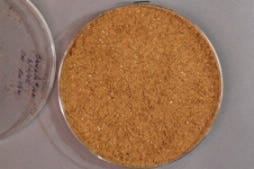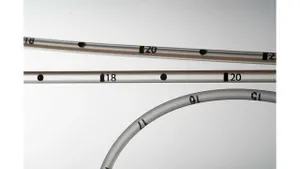Meat and bone meal blended with UHMWPE for partially biodegradable compound
Banned from use in cattle feed, billions of pounds of meat and bone meal could be diverted from landfills and into partially biodegradable plastic. Researcher Fehime Vatansever and her team reported their experiments using meat and bone meal (MBM) as a component of partially biodegradable plastics to the National Meeting and Exposition of the American Chemical Society at its spring event held March 27-31 in Anaheim, CA.
March 28, 2011
Banned from use in cattle feed, billions of pounds of meat and bone meal could be diverted from landfills and into partially biodegradable plastic. Researcher Fehime Vatansever and her team reported their experiments using meat and bone meal (MBM) as a component of partially biodegradable plastics to the National Meeting and Exposition of the American Chemical Society at its spring event held March 27-31 in Anaheim, CA.
Meat bone meal plastics. |
Researchers have combined meat bone meal, which is a rendered product made up of 50% protein, 9.5% fat, 10.1% calcium, and 4.8% phosphorous, with UHMWPE for a partially biodegrabable compound. |
The researchers mixed the MBM plastic with ultra-high-molecular weight polyethylene (UHMWPE) and conducted tests showing that the MBM/UHMWPE compound is almost as durable as standalone UHMWPE with the added bonus of being partially biodegradable.
Vatansever, who has a PhD in material science from Clemson University where she is a graduate research assistant, noted that more than 9 billion pounds of protein meal are produced by the U.S. rendering industry each year, with the bulk of that byproduct represented by meat and bone meal. Meal from cows had to be treated with harsh chemicals to destroy any bovine spongiform encephalopathy (BSE) and then put into special landfills. "We thought we could keep meat and bone meal from being deposited in landfills by using it to make petroleum-free bioplastics," Vatansever said.
The U.S. Food and Drug Administration (FDA) banned the practice of feeding meat and bone meal made from byproducts of slaughtered cattle, sheep, and farmed deer, elk and bison to those same animals in 1997, with other countries following suit.
The ban grew out of concern over the human form of Mad Cow Disease, a rare but fatal brain disorder that spread in the United Kingdom following the ingestion of infected meat. The researchers noted that as of 2010, only three cases of BSE, or Mad Cow Disease, had occurred in the U.S. The bans were intended to reduce the chances that meat and bone meal made from one infected cow could spread BSE widely throughout cattle herds.
Bernice M. Nzioki, a Clemson University graduate student, presented some of the initial findings on this matter in May 2010 as part of her masters of science, materials science and engineering, thesis. The paper, entitled Biodegradable Polymer Blends and Composites from Proteins Produced by Animal Co-Product Industry, stated that DSC thermographs of the MBM/UHMWPE blends showed that the thermal properties of UHMWPE did not change drastically as the MBM content was increased. The tensile strength and elongation, however, decreased with the addition MBM, while the modulus was boosted with increase in MBM. Nzioki determined that a 30:70 MBM:UHWMPE blend had the "most reproducible and useful properties."
The MBM used was a dry, rendered product from mammal tissues that usually contained 50% protein, 9.5% fat, 10.1% calcium, and 4.8% phosphorus. Nzioki said that the research team had successfully developed compression molded biodegradable plastic formulations from UHMWPE/MBM blends.
About the Author(s)
You May Also Like



